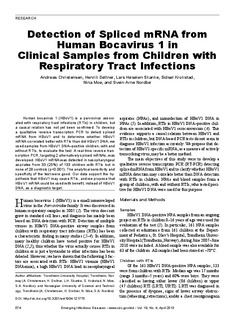| dc.contributor.author | Christensen, Andreas | |
| dc.contributor.author | Døllner, Henrik | |
| dc.contributor.author | Skanke, Lars Høsøien | |
| dc.contributor.author | Krokstad, Sidsel | |
| dc.contributor.author | Moe, Nina | |
| dc.contributor.author | Nordbø, Svein Arne | |
| dc.date.accessioned | 2016-11-16T14:45:31Z | |
| dc.date.accessioned | 2016-11-17T14:01:14Z | |
| dc.date.available | 2016-11-16T14:45:31Z | |
| dc.date.available | 2016-11-17T14:01:14Z | |
| dc.date.issued | 2013 | |
| dc.identifier.citation | Emerging Infectious Diseases 2013, 19(4):574-580 | nb_NO |
| dc.identifier.issn | 1080-6059 | |
| dc.identifier.uri | http://hdl.handle.net/11250/2421638 | |
| dc.description.abstract | Human bocavirus 1 (HBoV1) is a parvovirus associated with respiratory tract infections (RTIs) in children, but a causal relation has not yet been confirmed. To develop a qualitative reverse transcription PCR to detect spliced mRNA from HBoV1 and to determine whether HBoV1 mRNA correlated better with RTIs than did HBoV1 DNA, we used samples from HBoV1 DNA–positive children, with and without RTIs, to evaluate the test. A real-time reverse transcription PCR, targeting 2 alternatively spliced mRNAs, was developed. HBoV1 mRNA was detected in nasopharyngeal aspirates from 33 (25%) of 133 children with RTIs but in none of 28 controls (p<0.001). The analytical sensitivity and specificity of the test were good. Our data support the hypothesis that HBoV1 may cause RTIs, and we propose that HBoV1 mRNA could be used with benefit, instead of HBoV1 DNA, as a diagnostic target. | nb_NO |
| dc.language.iso | eng | nb_NO |
| dc.publisher | Centers for Disease Control and Prevention (CDC) | nb_NO |
| dc.title | Detection of spliced mRNA from human bocavirus 1 in clinical samples from children with respiratory tract infections | nb_NO |
| dc.type | Journal article | nb_NO |
| dc.type | Peer reviewed | nb_NO |
| dc.date.updated | 2016-11-16T14:45:31Z | |
| dc.source.volume | 19 | nb_NO |
| dc.source.journal | Emerging Infectious Diseases | nb_NO |
| dc.source.issue | 4 | nb_NO |
| dc.identifier.doi | 10.3201/eid1904.121775 | |
| dc.identifier.cristin | 1029290 | |
| dc.description.localcode | Emerging Infectious Diseases is an open access journal published monthly by the Centers for Disease Control and Prevention (CDC). The journal is published online and also has a limited print run on acid free paper that meets the requirements of ANSI/NISO Z39.48-1984 (Permanence of Paper). Publication in EID enables compliance with the NIH Public Access Policy | nb_NO |
